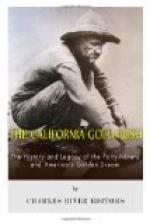The forces of Stockton and Kearny joined a few days later, and very soon a conflict of authority arose between the leaders. It was a childish affair throughout, and probably at bottom arose from Fremont’s usual over-ambitious designs. To Kearny had undoubtedly been given, by the properly constituted authorities, the command of all the land operations. Stockton, however, claimed to hold supreme land command by instructions from Commodore Sloat already quoted. Through the internal evidence of Stockton’s letters and proclamations, it seems he was a trifle inclined to be bombastic and high-flown, to usurp authority, and perhaps to consider himself and his operations of more importance than they actually were. However, he was an officer disciplined and trained to obedience, and his absurd contention is not in character. It may be significant that he had promised to appoint Fremont Governor of California, a promise that naturally could not be fulfilled if Kearny’s authority were fully recognized.
Furthermore, at this moment Fremont was at the zenith of his career, and his influence in such matters was considerable. As Hittell says, “At this time and for some time afterwards, Fremont was represented as a sort of young lion. The several trips he had made across the continent, and the several able and interesting reports he had published over his name attracted great public attention. He was hardly ever mentioned except in a high-flown hyperbolical phrase. Benton was one of the most influential men of his day, and it soon became well understood that the surest way of reaching the father-in-law’s favor was by furthering the son-in-law’s prospects; everybody that wished to court Benton praised Fremont. Besides this political influence Benton exerted in Fremont’s behalf, there was an almost equally strong social influence.” It might be added that the nature of his public service had been such as to throw him on his own responsibility, and that he had always gambled with fortune, as in the Bear Flag Revolution already mentioned. His star had ever been in the ascendant. He was a spoiled child of fortune at this time, and bitterly and haughtily resented any check to his ambition. The mixture of his blood gave him that fine sense of the dramatic which so easily descends to posing. His actual accomplishment was without doubt great; but his own appreciation of that accomplishment was also undoubtedly great. He was one of those interesting characters whose activities are so near the line between great deeds and charlatanism that it is sometimes difficult to segregate the pose from the performance.




